In the early days of traditional TV, consumers would watch the most popular shows offered by the broadcaster. Those days are long gone. In today's realities, viewers demand their shows whenever they want, anywhere (platform, TV screen size, and any other user device settings).
With such a fragmented audience, it can be challenging for advertisers and ad agencies to target the right audience and serve ads. This is where addressable advertising comes in. Let’s take a closer look.

What is addressable TV advertising?
Addressable TV advertising is a form of advertising where marketers can target video ads to specific households during regularly scheduled shows. It gets possible thanks to cable providers and set-top boxes. This approach is actively developing in the advertising industry, and many advertising agencies are already using it for media planning.
Specific households are selectively segmented by geography, behavior, or demographics. Then they are shown relevant ads while they watch TV online, streaming, or linear. In this way, connected TV helps potential clients get more personalized advertising.
In simple terms, marketers can now show specific TV ads to particular people and get households to watch ads based on their interests, habits, and demographics. By combining granular data and panel research, brands can potentially reach more relevant audiences right in their living rooms using professionally crafted TV content.
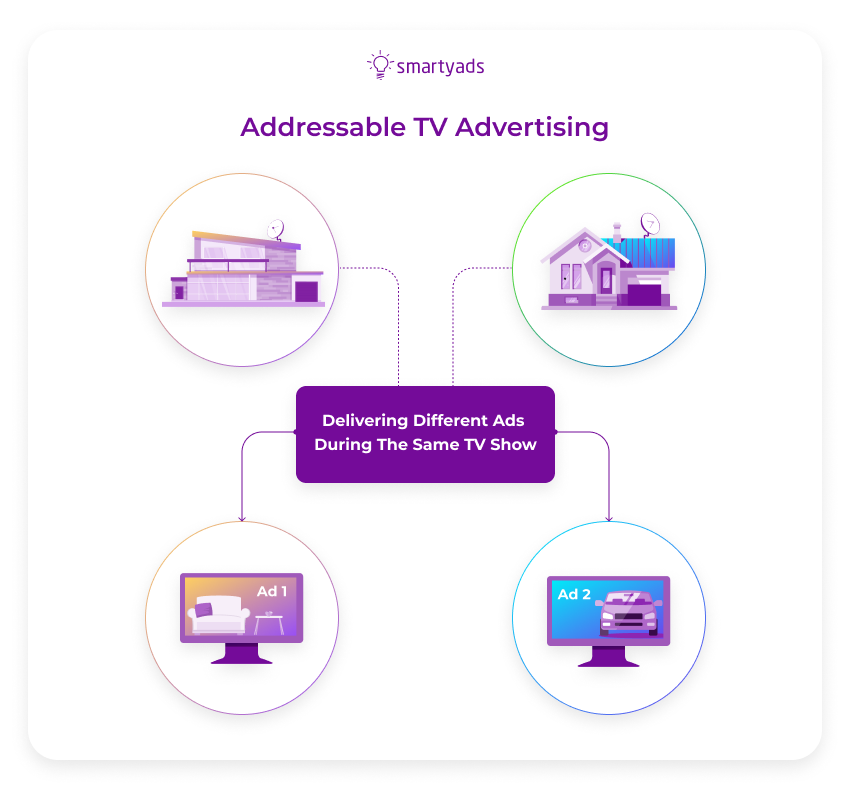
So, what is the difference between CTV and addressable?
So, addressable TV advertising is the ads that are individualized according to the household. On the contrary, CTV ads are delivered to Internet-connected devices and are often enabled by the programmatic algorithm.
This way, even though your users may be watching different shows, they see different ads, tailored specifically to their needs, which are determined by data-powered AI and ML algorithms. In other words, it’s programmatic on TV.
This allows marketers to move away from traditional, manual ad buys and focus more on how relevant their message is to their audience and measure the impact.
If you are a marketer, you can use CTV advertising to enhance your targeting efforts and reach custom audiences with added creativity. Thanks to a higher level of granular TV attribution, you can get even deeper insights into the overall performance of your ad.
How does addressable TV work?
Addressable TV advertising is different from traditional TV advertising because linear TV advertising is the same for everyone.
With addressable experience, marketers can choose their audience based on geographic location, demographics, or browsing habits. These advertisements are then broadcasted to selected households.
A vital element of the concept of addressable TV is data. Consumer data (programs watched, devices owned, websites visited, and behavior across devices) is collected by marketers and used to create household profiles. The data is often provided by cable providers. When campaigns are served through connected TVs they are usually served via programmatic and this means that programmatic platforms utilize available third-party data so that an advertiser could channel the ad to the right user/household.
These profiles are then shared with cable operators, OTT providers, and advertisers so that households can be targeted with specific ads according to their profiles.
How addressable TV is changing advertising
Most media buyers believe that addressable TV is now with us forever. Most likely, this trend will continue to grow, changing advertising. In its 2022 TMT Forecasts report, Deloitte Global predicted that addressable advertising would generate about $7.5 billion in 2022.
It is growing in popularity because it helps advertisers reduce ad waste and increase efficiency by showing ads only to targeted, relevant households.
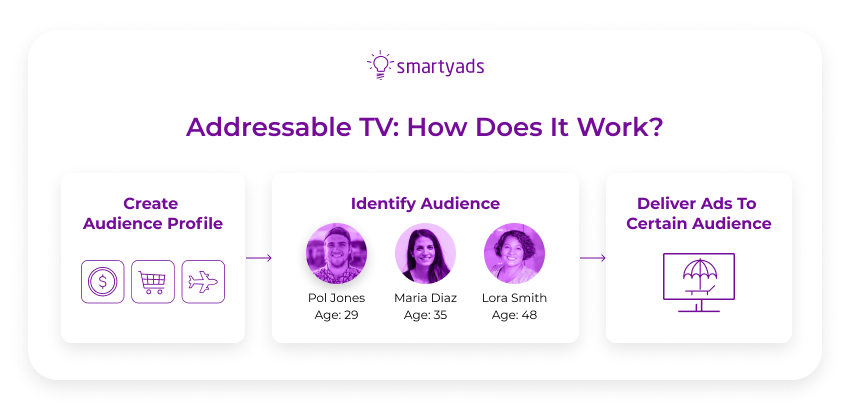
This ad method will not replace traditional TV ads though, but it is being used as an advanced way to target audiences. In addition, the number of platforms on which addressable ads can be placed is predicted to grow steadily over the next few years. This will further expand the reach of addressable television and help marketers improve brand relevancy and targeting strategies.

Addressable TV vs linear TV
Targeted advertising does not replace advertising on linear TV, but instead should be seen as an advanced way to buy your target audience (driven by data). Let's look at the difference between addressable TV and linear TV.
Linear TV advertising
Linear television advertising can only target age/gender across the entire linear landscape based on ratings for a particular show.
Linear TV advertising is also bought in advance, forcing advertisers to buy inventory based on the show, not the audience, and based on its rating.
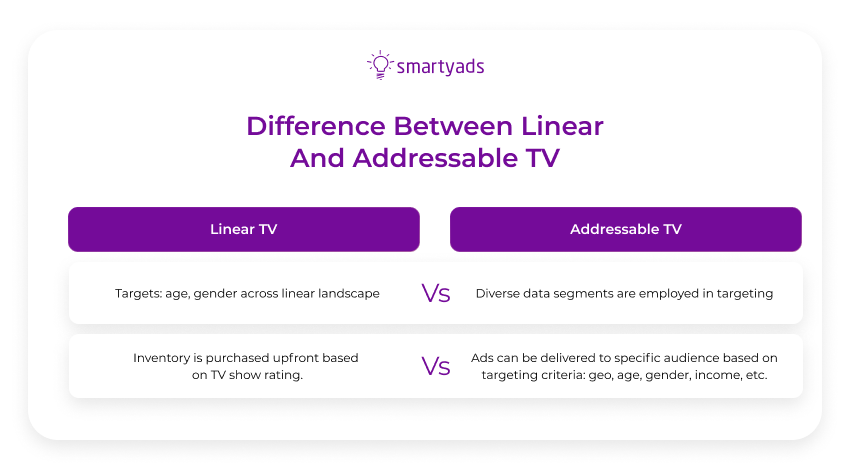
Addressable TV
So, is there a dilemma like addressable TV vs connected TV for digital advertising or digital marketing purposes? Both have opportunities for targeting. However, addressable TV ads are delivered to linear TV viewers through a set-top box. With CTV, digital advertising is delivered via Internet access.
Addressable technology allows you to use data segments in addition to age/gender to buy very specific audiences instead of basic age/gender groups. Thanks to this, the watcher gets customized messages.
On linear television, the TV ad is delivered to the user during commercial breaks (on traditional TV sets). With CTV the users can be streaming content through multiple platforms. Thus, an advertiser can reach consumers on different devices and elevate brand image on many screens.
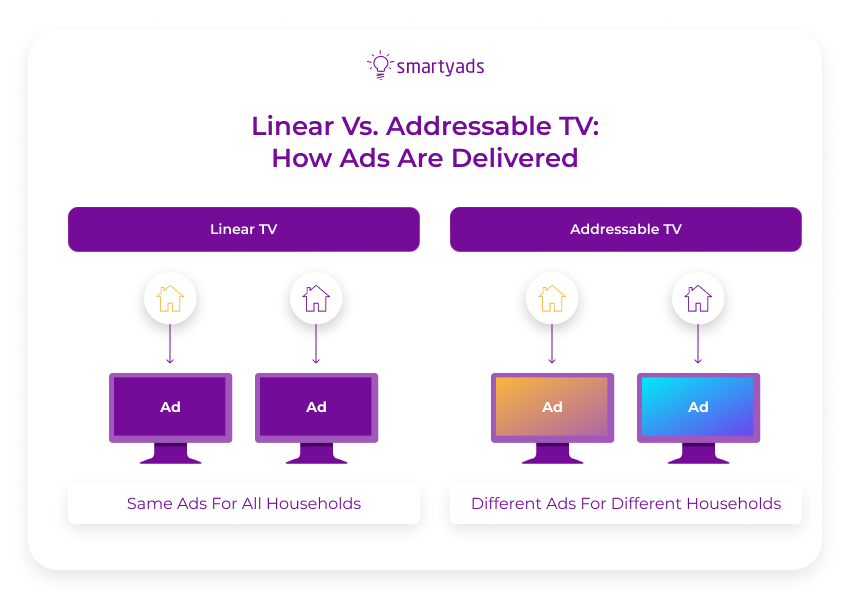
Addressable TV vs OTT
Addressable TV and OTT/CTV advertising capabilities deliver advertising to consumers with the ability to show different ads to various households while watching the same program.
Addressable TV is a method of delivering targeted advertisements to digital TVs connected to a cable. In contrast, OTT/CTV addressable is a method of delivering targeted advertisements to any device used to stream content via Internet services. Advertisers may shift their focus away from audience-targeting programs and opt for addressable ads.
Reaching cord-cutters with addressable TV advertising
We already mentioned that TV viewing habits have changed over the years, but this is especially evident when we look at the number of people who no longer subscribe to any form of paid television. In fact, according to IDC, 23% of households don’t have a pay TV subscription, and this number is expected to increase by 29% next year.
Studies that have been done on cord-cutting show that this shift is more about money than content. What it all boils down to is the format. The customers want to watch their favorite shows in the most convenient and cheapest way possible.
Millennials with a mid-level income usually watch Smart TVs and consume shows on demand. Therefore, more advertisers should use a targeted approach to reach them on all kinds of Internet-connected video streaming devices.
Dispelling 3 myths about OTT
Whenever a new disruptive technology comes along, there are bound to be some myths swirling around it. So, let’s dispel the most common myths about addressable TV advertising:
- It only makes sense if you have a small target audience. Even if you are targeting very broad audiences, you can still use the insights and data that you obtain to launch programmatic TV buying campaigns at scale;
- The CPM is too expensive for broad targeting. In a comparison of CPMs between addressable and linear TV, an addressable campaign is more expensive. However, you get more value with addressable since you deliver a targeted experience to the right media;
- Addressable TV is limited in terms of media. Addressable TV campaigns are not so dependent on media type since they are served mostly as digital videos. On top of this, addressable TV is excellent in terms of brand safety as it is fraud-free, such TV ad is often served on a large screen so it has better memorability.
Benefits of Addressable TV advertising
Joint viewing of programs reduces the cost of contact for marketers. Besides, brands can test formats and come up with non-standard advertising approaches since the functionality allows the viewer to go to the brand page after viewing ads, make purchases, see special offers, and participate in contests and promotions.
Also, marketers can run cross-channel campaigns using mobile devices, or “catch up” with advertising on other online devices.
The advertiser receives detailed data considering the effectiveness of an advertising campaign, evaluation of views/clicks/interactions with content, analysis of behavior, the reaction of viewers to this or that format, the ability to conduct polls, obtain feedback, and more.
Moreover, you will be able to see the effectiveness of your ads at scale which allows you to increase engagement by tailoring your content for specific audiences and devices.
Best practices for Addressable TV ads implementation
In order to enjoy all of the benefits addressable TV advertising has to offer, you need to implement it properly from the very beginning. Here are some tips on how to do this to serve ads effectively:
- Make sure that attribution measurements are set up so you can measure your KPIs;
- Your ads should have a widescreen aspect ratio of 16:9;
- The bitrate of your video must be at least 5,000 kbps;
- Use only VAST tags;
- Include both 15 and 30-second ads creatives;
- Include a CTA in your ad.
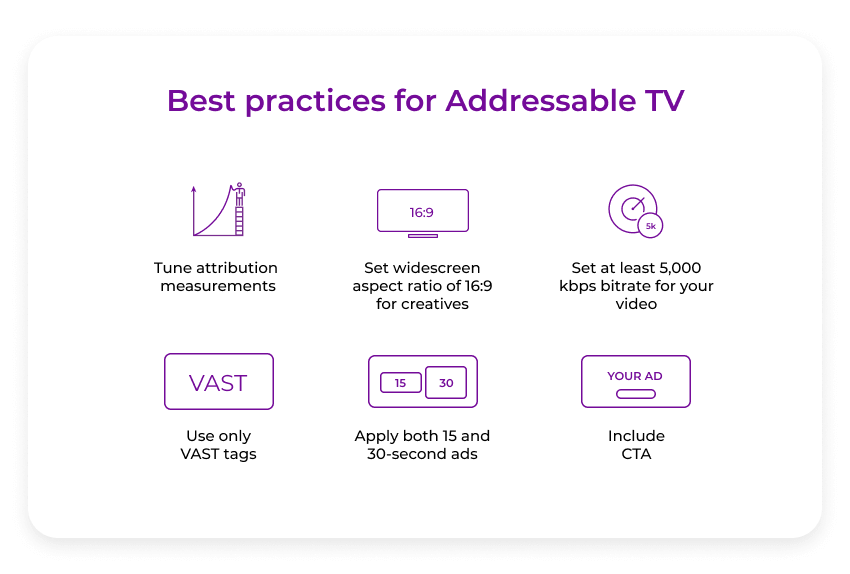
Concluding thoughts
The addressable TV allows both advertisers and publishers to use programmatic platforms which offer a wide variety of benefits. Just like with web programmatic ads, media buyers tune up their OTT campaign through DSP.
The publishers decide how they want the OTT ads to be displayed on their inventory and where. They can define the floor bid and other parameters they usually select on SSP.
Recently, programmatic OTT platforms have become very sophisticated in terms of segmenting audiences and performing in-depth campaign analysis.
With addressable TV advertisers no longer have to rely on schedules, since users consume content on demand. Just as importantly, the advertisers have control over how their message is delivered. They can manage how often their ads are shown and manage the overall reach to reduce audience fatigue and increase engagement.
DSPs offer incredibly detailed targeting, such as geography, browser, device, operating system, and dayparting. On SmartyAds DSP advertisers can access the best CTV traffic from top-notch global publishers.
SmartyAds helps brands deliver their message to the right audience at the right time and place. Need CTV traffic? Get registered at SmartyAds DSP!

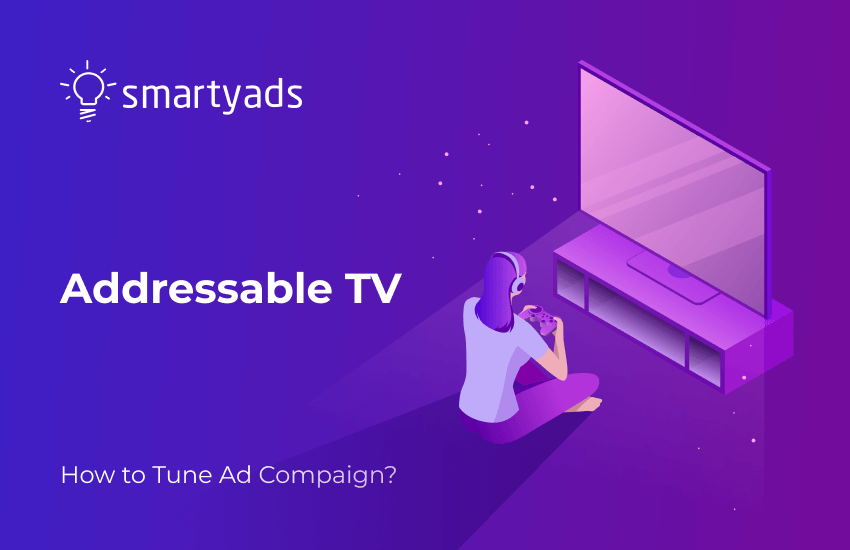
.webp)


